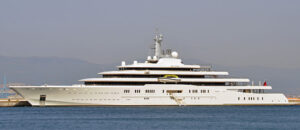
Superyacht ‘Eclipse’ berthed at the Detached Mole, Gibraltar. Courtesy Wikimedia Commons
As I write this, the World Superyacht Awards are wrapping up here, in the Monte-Carlo Sporting, the big venue for society fundraising in Monaco. Guests are moving slowly from the champagne reception into the festive Salles des Etoiles, where they will have dinner, and soon Neptune awards will be handed out to boat owners, designers, and builders of opulent boats built for private pleasure. (One Forbes writer gets around the definition of “superyacht,” since there are various measures, such as gross tonnage or length, by saying such a boat should have a tender that is “a limousine…crossed with a Ferrari.”)
The awards event in Monte Carlo is sold out, even though individual tickets were $2,200 plus VAT, and a “Superior Table” for 10 cost more than $21,000. Rooms at the group rate at participating hotels started at about $600 per night. After all, what are a couple of tens of thousands of dollars for a few hours’ entertainment, when your boat is as big, and perhaps more sophisticated in design and technology, as many nations’ frigates?
The Common Reader could not get tickets and did not try, so I am left to assume someone is reporting from the event, though I doubt if most of us will hear many details.
As one example of the class, the boat in the photo above, the MY Eclipse, was, when launched in 2010, the world’s largest superyacht, at 532 feet. It had six tenders (the smaller boats that take passengers to shore), 18 staterooms, a spa, gym, beach club, and, Wikimedia says, “a three-man leisure submarine, two swimming pools, intruder detection systems, accommodation for three helicopters, a German-built missile defense system and bullet-proof glass and armor plating in the master suite.”
It is owned now by Russian-Israeli businessman Roman Abramovich, said to be worth $12.9 billion in 2019. The Eclipse dropped to third-largest superyacht in the world this year but is valued at $1.2 billion, still making it “the world’s most expensive yacht.”
(If one wonders at the expense, here is an article on a different superyacht that 300 people labored on exclusively, every working day, for four years.)
The rich are different from you and me, as Fitzgerald said; they have bigger toys. Sometimes the toys draw so much water, and provide such a temptation to the unwashed masses, that they require deep-water berthing at their own islands built offshore. I had no idea of the numbers of these sorts of craft, or that there are so many people who think little enough of their expense to buy them and use them only periodically. (They are also rented, sometimes for more than a million dollars a week.)
These beautiful boats are built to be admired, by others as much as by their owners, but our admiration is meant to come to a full stop at marine-binocular distance. Several publications are in the business of further glamorizing them but rarely mention owners’ names, or detail the boats’ true costs, in materials, manufacture, labor, energy, or toll on the environment. To mention rising inequality and waste would just be outré.
The right audience might be interested, however, in how, in the super yacht world, “Both of our industry’s ‘key market health trackers’, new-build orders and second-hand sales, show very encouraging signs. Some of this is down to the general increase in wealth around the world, but the ‘race for space’ we have seen during the pandemic has also played its part.”
It is understandable this might be mistaken for suborbital space shots by American billionaires, but they mean having enough room on your boat to feel as if you can really stretch out.
To their credit, the judges of the Superyacht Awards in Monte Carlo are listed on the event’s site. Dick Raper is their Chairman. One site claims he is worth $100 million; his LinkedIn page says he “worked for the Mars family for 34 years in many different roles and countries including UK, USA, Europe, Russia and other emerging markets.” Raper has retired to the Bahamas—presumably where he berths his 125-foot sailing yacht, the Atalante—and now works with his son Piers “in the professional beauty sector in the UK and USA with Skinade, the multi award winning skincare supplement drink clinically proven to rejuvenate your skin.” Being on the open water under the merciless sun gives a person big ideas.
